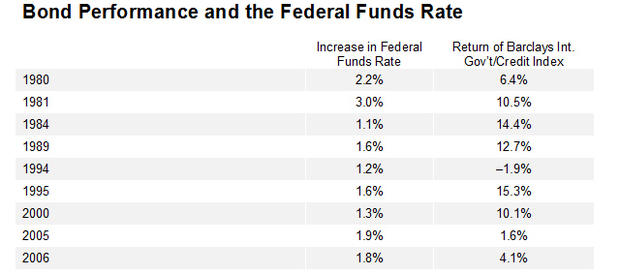How Bernanke's testimony affects investors
(MoneyWatch) The price of Treasury bonds fell sharply yesterday after Federal Reserve Chairman Ben Bernanke told Congress the Fed may cut the pace of bond purchases in the next few months if policymakers see indications of sustained economic growth. That pushed the benchmark 10-year Treasury note yield above 2 percent for the first time since March. It also raised fears about the damage that could be done to bond prices if rates rise.
But what action, if any, should investors take? That's easy: Nothing. To understand why, you need to know that long-term bond yields are basically the average of expected future short rates.
The federal funds rate is basically zero, the five-year Treasury is about 0.9 percent and the 10-year bond yields about 2 percent. As economist John Cochrane explains on his blog, given that today's short-term rates are well below today's 10-year rate of 2 percent for the first five years, then the market must expect them to be above 2 percent for the last five years and to rise to 4 percent within the 10 years.
- Know the data before buying high-yield bonds
- Is gold's price drop just the beginning?
- Is the U.S. economy in trouble?
The following is a simple example showing that knowing rates will rise isn't enough for investors to benefit. They have to rise more than the market already anticipates.
The one-year yield is 1 percent, and the two-year yield is 2 percent. You believe rates will rise, so you invest in the one-year security. Given that the market clearly anticipates that rates are going to rise, how much do rates have to rise in the next year to make your decision profitable?
To keep the math simple, we'll ignore compounding. Had you invested in the two-year, you would have earned a total of 4 percent over the period. Instead, you invested in the one-year and earned 1 percent in that year. So for you to come out ahead, the one-year rate must rise more than 2 percent to above 3 percent over the next year.
As Cochrane explains: "The forward curve has the nice property that if interest rates follow this forecast, then returns on bonds of all maturities are always exactly the same. The higher yields of long-term bonds exactly compensate for the price declines when interest rates rise."
What's missing from the above analysis is that because investors are risk averse, market yields also contain a risk premium -- for accepting term risk and the risk of unexpected inflation. Thus, longer-term bonds actually have higher expected returns (by the amount of the term risk premium) than shorter-term bonds.
The bottom line is that unless you can forecast rates more accurately than the market's consensus -- and we've seen how unlikely that is -- staying with very short-term bonds doesn't make much sense. And as investors have learned over the last five years, staying short creates reinvestment risk -- the risk that when short-term bonds mature rates will be lower, not higher.
The following table provides strong counterevidence to the idea that you can persistently time the bond market and support for why you should stick with your investment plan. The table covers the period 1980-2012 and shows the return on Barclay's Intermediate Government/Credit Index for only the years when the federal funds rate increased by more than 1 percent -- just the type period investors are worried about.
1994 was the only year when the federal funds rate rose by more than 1 percent and intermediate-term bonds lost money. Now, it's true that in those years investors had a cushion in the form of higher current yields than is available to today's investor. But the point still holds. It's also worth noting that 1994 was the only year since at least 1973 (the first year of the index) that the index produced losses. One reason is that short-term rates can rise without impacting the yields on longer maturities -- a point lost on many investors. Another is that the term premium provides enough of a benefit to offset a rise in interest rates for the remaining term.
Finally, it's also worth noting that even the suggestion that the Fed might begin to cut down the pace of its bond buying program led to another sharp drop in the price of gold. Gold fell $18 to about $1,360 an ounce. Imagine what might happen when the Fed actually begins to tighten policy, raising the opportunity cost of holding gold instead of bonds. If you need a reminder of what can happen, just look back to 1980 when gold fell from $850 an ounce in January to just $590 by year-end, and then fell to under $400 by the end of 1981, a drop of about 53 percent.
